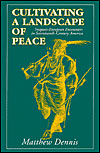 |
Cultivating a Landscape of Peace
Iroquois-European Encounters in Seventeenth-Century America
This book examines the peculiar new worlds of the Five Nations of the Iroquois, the Dutch, and the French, who shared cultural frontiers in seventeenth century North America. Matthew Dennis employs methods and materials from a range of disciplines, including archaeology, ethnology, folklore, literary criticism, and history, to reconstruct those worlds and analyze the consequences of their mingling with one another. Dennis likens his book to a cubist painting that describes and orders multiple elements on canvas but consciously avoids dissolving them into a single angle of vision. Viewing early America from the different perspectives of the diverse people who coexisted uneasily during the colonial encounter between Europeans and Indians, he explains a long-standing paradox: the apparent belligerence of the Five Nations, a people who saw themselves as promoters of universal peace. In a radically new interpretation of the Iroquois, Dennis argues that the Five Nations sought to incorporate their new European neighbors as kinspeople into their Longhouse, the physical and symbolic embodiment of Iroquois domesticity and peace. He offers a close, original reading of the fundamental political myth of the Five Nations, the Deganawidah Epic and situates it historically and ideologically in Iroquois life. Detailing the particular nature of Iroquois peace, he describes the Five Nations' diligent efforts to establish peace on their own terms and the frustrations and hostilities that stemmed from the fundamental contrast between Iroquois and European goals, expectations, and perceptions of human relationships.
— ©1995
|

